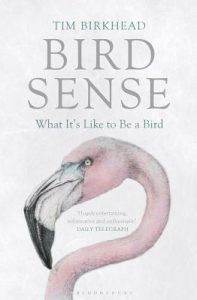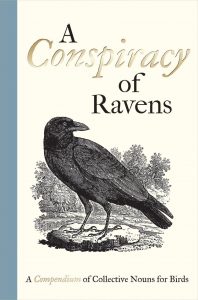 Bird Sense is all about, well, bird senses. The senses of birds. The way birds sense the world around them, in a slightly different way than The Thing with Feathers, which I’ll discuss a bit in more detail below. Interestingly enough, Birkhead covers more than just the five human senses, including magnetic sense as well as – whether you agree that this is a sense or not – emotion.
Bird Sense is all about, well, bird senses. The senses of birds. The way birds sense the world around them, in a slightly different way than The Thing with Feathers, which I’ll discuss a bit in more detail below. Interestingly enough, Birkhead covers more than just the five human senses, including magnetic sense as well as – whether you agree that this is a sense or not – emotion.
If anyone has ever read Nagel’s What is it Like to be a Bat?*, you might be thinking, “well, there’s really no way to understand what it’s like to be a bird” (unless you read the paper and didn’t come away from it agreeing with Nagel), and I suppose you’re right, to a degree: we’re not birds, after all, so no matter how we try to simulate what we think are their experiences of the world around them, there is really no way to know what it is to be a bird.** But it’s not quite strictly speaking necessary, is it? While Birkhead doesn’t provide a complete physical theory of bird senses, he certainly tries to help the reader understand what it is like to be bird, from the senses that we share with them (to a degree) – smell, sight, touch, taste, hearing – to those we have no such access to, such as magnetic orienteering. And then there’s the fact that each species has different specs (it’s kind of like those infographics where you can draw out the shape of the strengths and weaknesses of each creature, and every species would have a different shape).
The writing is quite easy to engage with, and Birkhead presents a lot of the information straightforwardly, making this a great read for those of us who have precious little background in the natural sciences or of how birds work! There are anecdotes taken from Birkhead’s own experiences interspersed with information from studies about bird senses, and Birkhead does a great job making the information accessible. You’ll also learn about the history of our understanding of each of the senses – such as how the accepted explanation for bats being able to navigate in the dark was, for a time, due to touch rather than sound – and how that understanding has changed over time. Also, fun fact: did you know certain birds (e.g. oilbirds and a type of swift) also use echolocation, albeit at a lower frequency? Which tells us also about how perhaps birds have physical limitations to how their hearing might be adapted, because these birds are unable to sense smaller obstacles in their flight trajectory than a bat might be able to.
I personally also found that this was a nice companion to Why Did the Chicken Cross the World? by Andrew Lawler, as I was reading these side by side and happened to read the latter half of the chicken book after reading the chapter on Touch, which made everything about the practice of debeaking all the more brutal.
There’s also an interesting Quanta article on hyperuniformity in chickens’ eyes, if you’d like to know more about chicken eyes and vision.
Now we’re going to move onto The Thing with Feathers, which also covers in part some bird senses.
